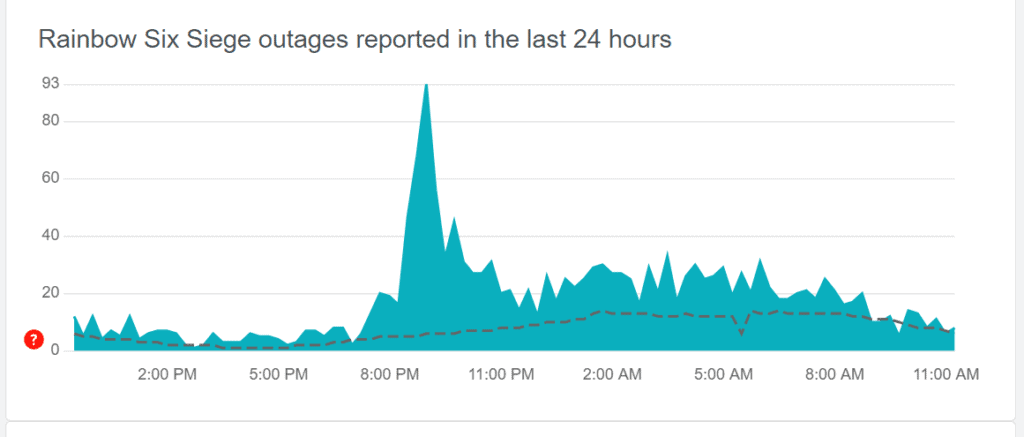Are you a Rainbow Six Siege enthusiast who’s been frustrated by server connection errors? You’re not alone.
The error message says, “Rainbow Six Siege server connection error
Rainbow Six Siege error code: [8-0x00003700]
The Rainbow Six Siege servers are unreachable. Please try again later.
For more information, contact http://support.ubisoft.com “
Many players have encountered issues when trying to connect to the game’s servers, leading to a less-than-ideal gaming experience. Fortunately, there are several effective solutions to address these server connection errors and get back to enjoying the game seamlessly.
In this blog, we’ll explore practical methods to troubleshoot and resolve Rainbow Six Siege server connection errors, ensuring that you can dive back into the action without unnecessary interruptions.
How To Fix Rainbow Six Siege Server Connection Error?

To fix the Rainbow Six Siege “Server connection” error you can check for server outages, restart you network devices, adjust firewall and antivirus settings. Additionally, you can update network drivers, disable background application, and enable UPnP on your router.
1. Check For Server Outages In Rainbow Six Siege

The problem might not be on your end at all. Server outages or maintenance can prevent you from connecting to the game. You can check the server status by
- Visiting the official Rainbow Six Siege server status page.
- Check Ubisoft’s official Twitter account or other social media for updates.
- Looking at Downdetector for reports about server issues.
2. Restart Your Network Devices
Resetting your network hardware can resolve a variety of connectivity issues.
- Turn off your modem and router and unplug them from the power source.
- Wait for about 30 seconds to a minute.
- Plug them back in and turn them on, then wait for the devices to fully restart and try connecting to the game again.
3. Adjust Firewall And Antivirus Settings
Sometimes firewall or antivirus settings can block Rainbow Six Siege’s server connection. Make sure Rainbow Six Siege is listed as an exception in your firewall and antivirus program settings.
To Add Rainbow Six Siege as an Exception in Firewall:
- Go to Control Panel > System and Security > Windows Defender Firewall.
- Click on “Allow an app or feature through Windows Defender Firewall“.
- Select “Change settings” and then “Allow another app“.
- Add Rainbow Six Siege and check it for both private and public networks.
To Add Rainbow Six Siege as an Exception in Antivirus:
- Open the antivirus application.
- Go to the settings or exceptions area.
- Add Rainbow Six Siege as an exception or allowed program.
4. Update Network Drivers
Out-of-date network drivers can cause connectivity issues in online games. Ensuring that you have the latest drivers can help improve your network performance.
- Go to the Device Manager on your PC (you can search for it in the Windows search bar).
- Find Network Adapters and expand the list.
- Right-click on your network adapter and select ‘Update driver‘.
- Choose ‘Search automatically for updated driver software‘ and follow the prompts.
5. Disable Background Applications
Applications running in the background can consume bandwidth and interfere with your game’s connection. Closing these can help ensure Rainbow Six Siege has the resources it needs.
- Press Ctrl + Shift + Esc to open the Task Manager.
- Look for applications that might be using the internet (like downloads or streaming services).
- Select these applications and click ‘End Task‘ to close them.
- Try launching Rainbow Six Siege again.
6. Enable UPnP On Your Router
UPnP helps devices on your network to automatically open the ports they need, which can simplify the process of connecting to game servers.
- Access your router’s admin page by typing the Default Gateway IP into a web browser.
- Log in with your router’s credentials (found in the router’s manual or on the device itself).
- Locate the UPnP setting (usually under the ‘Advanced‘ or ‘Network‘ settings).
- Enable UPnP and save changes.
7. Forward Ports For Rainbow Six Siege
Port forwarding is a more manual approach to ensuring that your router allows traffic to and from the game on specific ports. This can help establish a more stable connection.
- While still logged into your router’s admin page, look for the Port Forwarding section.
- Enter the IP address of your gaming device to tell the router where to send the game traffic.
- Input the TCP and UDP ports for Rainbow Six Siege as listed earlier.
- Save the changes and restart your router.
8. Use A VPN Connection
Sometimes your network route to the game servers might be problematic. Using a VPN can provide an alternative path and potentially resolve connection issues. When choosing a VPN
- Opt for a gaming-optimized VPN to minimize latency.
- Connect to a server that’s geographically close to Rainbow Six Siege’s servers.
9. Verify Game Files (for Steam Users)
It is a good idea to ensure that your game files are intact. Corrupt or missing files can lead to connection issues.
- Open your Steam client and navigate to your Library.
- Right-click on Rainbow Six Siege and select ‘Properties‘.
- Click on the ‘Local Files‘ tab and then select ‘Verify integrity of game files‘.
- Steam will then check your files and repair any issues found.
10. Switch To A Wired Connection
Wireless connections can be less stable than wired ones, which may contribute to server connection errors. Using an Ethernet cable can give you a more reliable connection.
Connect your gaming device directly to your router using an Ethernet cable to see if this improves your connection.
11. Contact Ubisoft Support

If none of the above solutions work, you may need to contact Ubisoft support for further assistance.
They can provide more detailed troubleshooting based on your specific situation.

